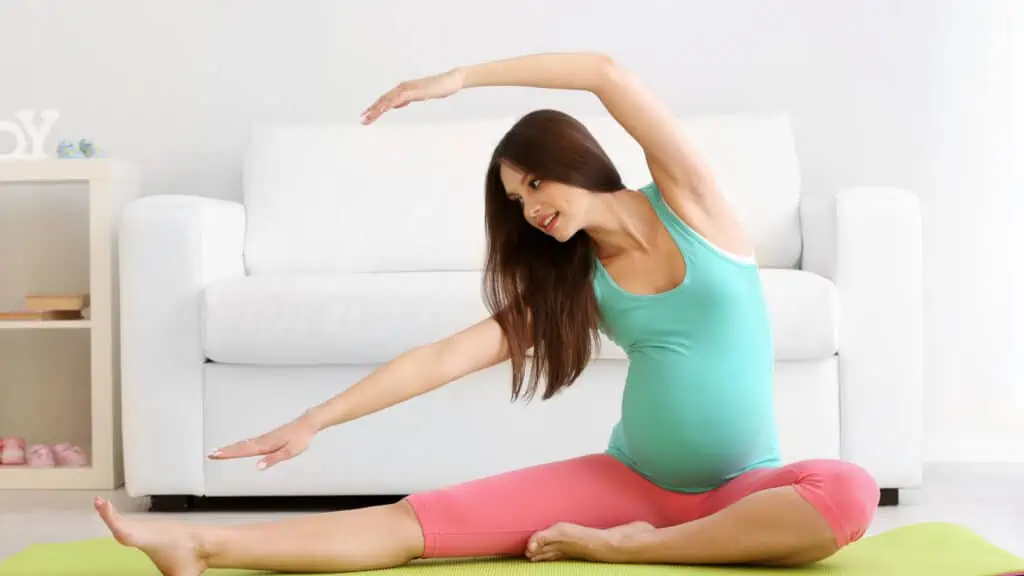The Best Pregnancy Exercises by Trimester
This post may contain affiliate links. As an Amazon Associate, I earn from qualifying purchases.
Congratulations, future mama! As you embark on your incredible pregnancy journey, staying active can help boost your mood and prepare your body for childbirth and parenthood. Whether you’re one, four, or nine months along, exercise is an important part of pregnancy health. Pregnancy-safe exercises prioritize gentle movement, focusing on maintaining fitness, flexibility, and strength without stressing your body or risking injury.
Benefits of exercising during pregnancy
Source: NAR studio/Shutterstock.com
Pregnancy exercise has many physical and mental benefits, from better sleep to reduced aches and pains.
- Combats fatigue and is a natural mood-elevator
- Helps reduce pregnancy aches and pains by keeping your body limber and strong
- May contribute to more restful sleep
- Helps with constipation
- Improves overall fitness level to prepare for labor
- Certain exercises strengthen your core and pelvic floor, which can help prepare your body for pregnancy and childbirth
- Helps manage weight gain throughout your pregnancy
According to The American College of Obstetricians and Gynecologists, continuing or starting regular physical activity is safe if you are healthy and have a normal pregnancy. However, talking to your OB-GYN about exercise during your initial prenatal visits is essential. Your doctor can assess your health and provide personalized guidance to ensure your workout routine suits you and your baby.
Ready to get moving and take your baby along for fitness fun? Here’s a trimester-by-trimester guide to safe and effective exercise during pregnancy.
First trimester: Embrace gentle movement

The first trimester can be a whirlwind of emotions—plus, you may be dealing with fatigue and morning sickness. Gentle exercises, such as the following, can help boost your mood and energy.
Walking
Lace-up your comfy shoes and explore your neighborhood, park, or even your living room. Walking is low-impact, accessible, and a great way to clear your head. Aim for 30 minutes most days, breaking it down into smaller chunks if needed.
Swimming
Water’s buoyancy takes the pressure off your joints and supports your growing bump. Try gentle laps, aqua aerobics, or simply float and relax.
Prenatal yoga
Enjoy the benefits of uniting breath with movement. Prenatal yoga offers a gentle but effective way to stretch, strengthen, and connect with your changing body. It’s also excellent for stress management.
Moderate intensity exercises
The American College of Obstetricians and Gynecologists recommends that pregnant women get at least 150 minutes of moderate-intensity aerobic activity weekly. A dance class, riding a stationary bike, or using an elliptical machine are examples of these activities that can benefit your cardiovascular health.
Second trimester: Build strength and stamina

The second trimester might feel like your golden era. With morning sickness possibly in the rearview mirror, you may feel more energized. Months four, five, and six could be the ideal time to focus on your prenatal strength routine. Don’t worry, we’re not talking Olympic weightlifting here; let’s explore some safe and effective options (and don’t forget you can still do all of the options from first trimester):
Light weights and resistance band exercises
These versatile tools let you target specific muscle groups, from your arms and shoulders to your core and legs. Start with light weights and gradually increase as you get stronger. Proper form is key to avoiding injury and strain, so don’t hesitate to ask a trainer for guidance.
Squats and lunges
These bodyweight exercises are fantastic for working your lower body, building stability, and preparing your body for carrying (and chasing!) your little one. Start with squats and lunges, and consider adding light weights as you get comfortable.
Prenatal Pilates
This low-impact workout is another option for building core strength and improving flexibility. It also focuses on proper alignment and posture to promote support for your growing belly and help you avoid aches and pains.
Third trimester: Move with mindful joy

As your bump gets bigger, so does your need for mindful movement. Fortunately, there are plenty of fun and effective ways to stay active and comfortable in the final stretch:
Dance
Put on your favorite tunes and groove! Gentle dance moves like swaying, side steps, and arm circles are a fun way to stay active and ease stress. Plus, it’s a great bonding experience with your little one (they might even tap their toes inside!).
Walk
While it may be hard to get around these days, getting out for a daily walk is great for the core, hips, and pelvis. Plus, the fresh air will be good for our mental health. It can also help get baby in the right position for labor.
Maintain your regular routine with your doctor’s OK
As long as your OB-GYN gives you the green light, you can continue walking, swimming, and doing the workouts you’ve been doing all along.
Exercises to avoid during pregnancy
Always check with your doctor about your exercise routine and activities, but the following should generally be avoided when pregnant.
Contact sports
Sports like soccer, horseback riding, skating, or downhill skiing may put you at risk of falling or getting hit in the belly.
Hot yoga
The high temperatures in hot yoga can raise your core body temperature, which could harm your baby’s development. You can also become dehydrated.
Scuba diving
Scuba diving’s pressure changes pose risks to fetal development and maternal health.
Exercises that require being flat on your back
During the third trimester, avoid exercises that require being flat on your back—those ab crunches can wait. Lying on your back puts pressure on a major vein, potentially lowering blood pressure and reducing blood flow to your baby.
Other pregnancy and exercise tips
Aerobic, strength, and conditioning exercises contribute to a healthy pregnancy, but keep the following in mind:
- Get clearance for your workout. Discuss your exercise plans with your doctor. Every pregnancy is different, and some physical activities may not be right for your specific circumstances.
- Hydrate, hydrate, hydrate. Drink plenty of water before, during, and after your workouts to stay refreshed and avoid dehydration.
- Fuel your body with nutritious foods. Eating a balanced pregnancy diet with plenty of fruits, vegetables, whole grains, and lean protein will give you the energy you need to move and nourish your growing baby.
- Listen to your body’s signals. Your body is your guide. Take breaks when needed and modify exercises if they feel uncomfortable.
- Watch your balance. By month six, your center of gravity has likely shifted forward, so be cautious. Make the necessary adjustments to your exercises as your body changes.
Strong mom, strong start
Exercise during pregnancy isn’t just about staying fit; it’s about honoring your body’s strength and embracing the amazing changes happening inside. Gentle movement connects you to your growing baby. It supports both your well-being and your little one’s development as you create a foundation for a lifetime of shared adventures.








